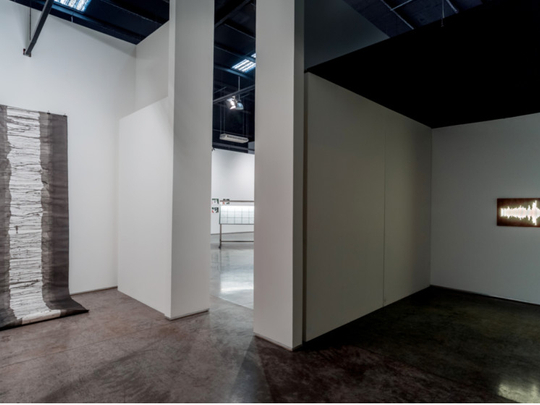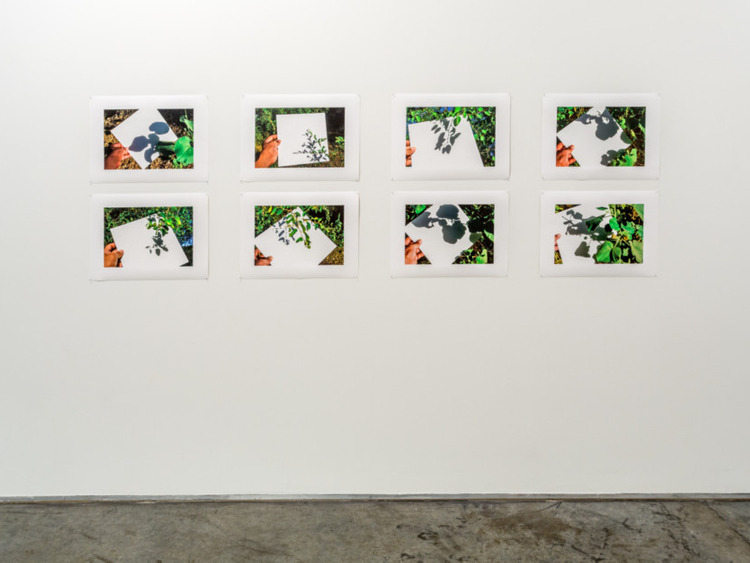
Mohammed Kazem’s work is simple, minimalist, playful and profound. The multi-media artist, recognised as one of the pioneers of contemporary art in the UAE, has always looked for inspiration in his surroundings. His work speaks about the society he lives in and the rapid changes that have happened in the UAE. Kazem also has an abiding interest in creating visual interpretations of transient, intangible, abstract elements such as sound, light or the ambience of a place. Over the last four decades he has devised various innovative ways to do this, such as his well-known Scratches series, where he depicts sound vibrations as a series of scratches on paper.
In his latest exhibition in Dubai, Receiving and Collecting, Kazem takes this concept further with works that seek to capture the presence and movement of light, or represent the sound and feel of specific spaces. The show also includes a set of 108 figurative drawings from his ongoing Windows series and new abstract gestural works from his Experiment series. The artist has used a variety of media and techniques such as graphite, ink, acrylic paints, photography, performance, embroidery, scratching and light boxes to create these works.
“My work is about capturing different elements in the environment around me,” Kazem says. “When I see the sunlight creeping into my room, and watch the play of light and shade as the rays of the sun sweep across buildings and go in and out of windows, I can feel an innate music in this movement. I wanted to create a visual representation of this invisible, inaudible, infinite rhythm of nature.”
He began to capture these fleeting moments by taking photographs of the patterns created by the light falling on his balcony wall, or the floor in his room - an act that he describes as ‘receiving’ the light. Later, he wandered out to take similar photographs in his neighbourhood. The result is a series of abstract works with light and dark geometric forms that are compositions made by nature. In a final touch, he has made scratches on the inkjet prints on Hahnemuhle paper to depict the intensity and movement of the light in the areas where it fell.
Not content to passively receive light, Kazem began going out to actively ‘collect’ light from places such as an abandoned house in Khor Fakkan, the desert, and the streets and gardens of the UAE. He collected light by placing a piece of white paper in his environment -- on the textured, crumbling wall of the house, next to rocks in the sand, or below the branch of a tree -- and taking photographs of the light and shadows created by the objects on the paper and around it. As a performative gesture, his hand can be seen in the photographs holding the paper. Once again, he has scratched the prints to emphasise the presence of the light.
“Through these photographs, I have tried to transform a transient moment into something tangible,” the artist says. “Each of these works is unique because the scratches on each one have a different sound and shape, reflecting the different interactions between the light and the surfaces it touched.”
Since Kazem is a trained musician, sound is an important theme in his work. During a recent residency in South Korea, he expressed his impressions about the new environment through works that translate the sound of different areas into soundwave patterns embroidered with thread on delicate hanshi paper, or laser cut on steel in a light box.
“I recorded the sounds at railway stations, and in restaurants, shops and streets that I visited. I have represented the feel of those places by using various visual elements connected with them to create the sound waves in my embroidered works,” Kazem says. “For example, I used thread of the same blue colour as the train to represent a train journey and I used materials bought from a fabric shop to recreate the ambience of the store. The light box represents the sounds and environment of a street that is lined with shops specializing in LED lights and metal working. In this series, I received and collected sounds and materials from the shops and often commissioned the same shops to help me create the works.” Another sound themed work in the show is Sculpting Sound from 2012. Here, the artist has covered a piece of fabric with phrases in various languages and embellished it by hand with shiny sequins. The work represents the ambience of a popular Dubai lounge that has now been demolished to make way for new construction and reflects the changes in the city as well as its multicultural ethos. “I wanted to visualise that quintessential Dubai experience of passing by the door, or sitting in a busy public venue and catching snatches of conversations in different languages,” Kazem says.
The artist is also showing new works from his Experiment series, where he creates patterns on both sides of a roll of paper by dunking the roll in a barrel of ink or acrylic paint and moving it around in different ways. The patterns thus represent a visual trace of the artist’s movements and gestures.
There is a sharp contrast between these conceptual works and Kazem’s Windows series, which comprises of pencil drawings on paper that attest to his classical art training and keen observation of his surroundings. He began the series over a decade ago with drawings of scenes he saw from his window and later expanded it by going out into the city to ‘collect’ new elements and experiences.
The black and white drawings from 2011 and 2012 collectively present a narrative about Dubai and the everyday life of the city’s residents. They subtly comment on the contrast between old and new Dubai, and between the lives of labourers and construction workers who are helping to build the city and the wealthy people who reside in the buildings and hotels built by them.
Receiving and Collecting, 2017, will run at Gallery Isabelle van den Eynde until February 23.
Jyoti Kalsi is an arts-enthusiast based in Dubai.













